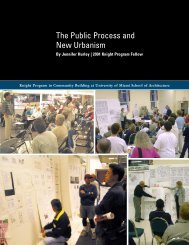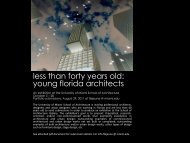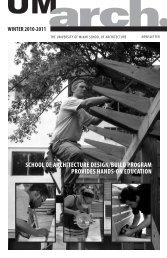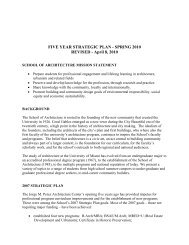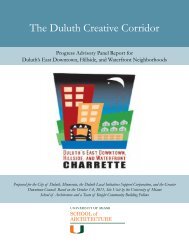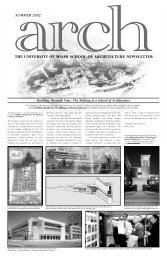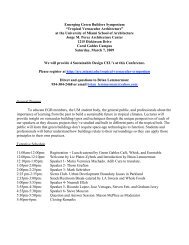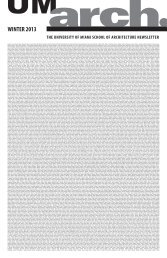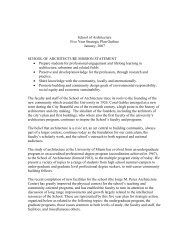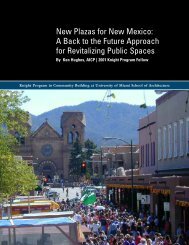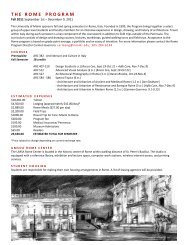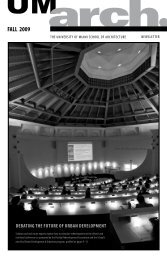Resilience - University of Miami School of Architecture
Resilience - University of Miami School of Architecture
Resilience - University of Miami School of Architecture
Create successful ePaper yourself
Turn your PDF publications into a flip-book with our unique Google optimized e-Paper software.
A resilient ecosystem needs to have stable populaons <strong>of</strong> the core group<br />
<strong>of</strong> species and stable funcon in terms <strong>of</strong> ability to propagate itself. For this to<br />
happen, it must have a stable physical structure. This is the definion <strong>of</strong> habitat:<br />
a physical structure which allows for the successful propagaon <strong>of</strong> a community.<br />
In developing the idea <strong>of</strong> a resilient campus supporng connuing<br />
high-level study <strong>of</strong> the marine environment, a program can be defined which<br />
enumerates the variety and proporon <strong>of</strong> various funcons. However, in the<br />
same way that neither a plant nursery nor a pet shop is an ecosystem, a collecon<br />
<strong>of</strong> specified spaces does not inherently make an academic community.<br />
The queson becomes, what constutes resilient habitat for the RSMAS community?<br />
The following paragraphs examine the dialecc between formalism<br />
and funconalism as generators <strong>of</strong> architectural and urban paern. Rather<br />
than viewing them as mutually exclusive approaches, I would argue that they<br />
are inherently complementary.<br />
The two pairs <strong>of</strong> text above illustrate two separate but overlapping debates<br />
on the nature <strong>of</strong> contemporary architecture and urban design. At the urban<br />
design scale, Landscape Urbanism is challenging the formalist basis <strong>of</strong> New<br />
Urbanism in favor <strong>of</strong> a fluid reading <strong>of</strong> urban space which emphasizes interconnecvity<br />
<strong>of</strong> infrastructure and ecological systems overlaid with site specific<br />
narrave reference. The first reference is an excerpt from Charles Waldheim’s<br />
introducon the Landscape Urbanism Reader, a collecon <strong>of</strong> essays which<br />
suggest a framework for meaningful urbanism in the post-industrial city. The<br />
emphasis is on reappropriaon <strong>of</strong> the horizontal plane, replacing the insustrialized<br />
asphalted ground plane with contemporary gardens which provide ecological<br />
funcon in addion to providing space for social interacon. Andres<br />
Duany has explicitly cricized this movement for its inability to address ques-<br />
ons <strong>of</strong> architectural density, spaal hierarchy, and funconal efficiency which<br />
constute important elements <strong>of</strong> New Urbanist theory. That he sees it as a<br />
threat to the supremacy <strong>of</strong> New Urbanism is an indicaon <strong>of</strong> the resonance <strong>of</strong><br />
the Landscape Urbanist approach in contemporary culture, as well as the con-<br />
nuing percepon that urban design theories are mutually exclusive. I would<br />
argue that both theories provide valuable tools for analyzing and designing the<br />
contemporary city, and are in fact quite complementary.<br />
high line park<br />
An example <strong>of</strong> the successful integraon <strong>of</strong> ideals from both camps can be<br />
found in the redevelopment <strong>of</strong> New York’s High Line. A mile long ribbon <strong>of</strong><br />
green floang over Manhaan’s Lower West Side, the High Line opened to the<br />
public in June 2009. The High Line is the glamorous cousin <strong>of</strong> the “rails to trails”<br />
projects which have gradually been transforming disused rail corridors into<br />
linear public open spaces. Combining an innovave design, high quality materials,<br />
and meculous quality <strong>of</strong> construcon, the inial secon <strong>of</strong> the High Line<br />
Park has become a showpiece <strong>of</strong> contemporary urban public space. However,<br />
1. High Line Park. author photo<br />
underneath the showy visuals lies a thoughul strategy for the transion <strong>of</strong> an<br />
underulized industrial quarter into a vibrant mixed-use urban neighborhood<br />
with the park at its heart. While the spectacular Manhaan locaon is unique,<br />
the project represents a scalable and replicable approach for catalyzing redevelopment<br />
<strong>of</strong> centrally located industrial districts.<br />
Running from West 34th Street south to Gansevoort Street, a block east <strong>of</strong><br />
the Hudson River, the High Line was constructed in 1934. The 1.5 mile rail line<br />
was elevated 30 feet to separate industrial rail acvity from surface streets.<br />
The line was placed mid-block north to south in order to avoid the blight associated<br />
with elevated subways (Friends <strong>of</strong> the High Line, 2010). The railroads<br />
owned an elevated easement, but the land underneath and air rights connued<br />
to be aached to adjacent lots. This created a unique urban paern which<br />
has impacted contemporary opons for redevelopment.<br />
By the 1980’s the line was unused and owners <strong>of</strong> adjacent properes formed<br />
Chelsea Property Owners, Inc. promong demolion in order to facilitate redevelopment<br />
<strong>of</strong> their land. However, rail preservaon advocates fought the<br />
demolion, and in 1999 neighborhood residents Joshua David and Robert<br />
Hammond founded the non-pr<strong>of</strong>it Friends <strong>of</strong> the High Line, seeking redevelopment<br />
<strong>of</strong> the structure as a unique public open space. Despite the concern <strong>of</strong><br />
adjacent owners, polical support for a public adapve re-use and the lack <strong>of</strong><br />
open space in that poron <strong>of</strong> the city led to a commitment from the City and<br />
the State to preserve the line. (Design Trust, 7)<br />
9.<br />
Case Studies<br />
35




